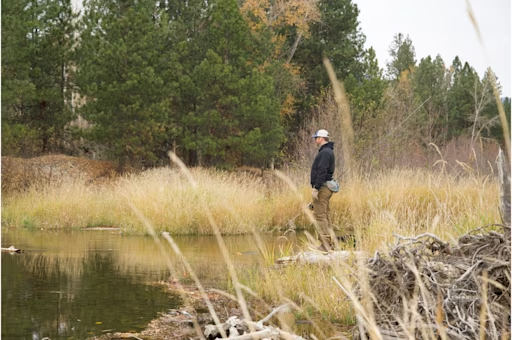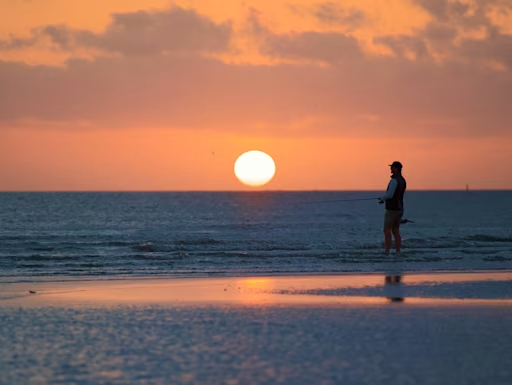Ultimate guide to fishing weather forecasts
Learn more about how rain, wind, tides, light and more all affect the success of your fishing experience.
Share this article

Did you know that weather plays a huge role in fishing? It not only affects how active the fish are and how likely they are to bite, but also plays a role in what species you may catch.
Weather variables, from temperature and wind to barometric pressure, all affect how likely fish are to feed on a particular day. Make sure to check the fishing forecasts in Fishbrain for up-to-date information on weather trends and fishing conditions.
Let’s take a deep dive into the weather and how it relates to fishing.
How the temperature affects fish activity
Remember that fish are cold-blooded creatures, so they cannot regulate their temperature as easily as humans can, and as a result, are more susceptible to temperature shifts. The colder the weather is, the slower the fish’s metabolism will be, meaning it will require less food than normal to maintain their body functions. Conversely, when the water is warmer, fish tend to be more active. Because they have higher activity in higher temperatures, they are more likely to eat than they are when it's colder.
This does not necessarily mean you will see an increase in fish activity on hot summer days though, remember fish also require dissolved oxygen in the water in order to breathe. The hotter the water is, the less dissolved oxygen they have available to them. The ideal weather condition will have an increase in metabolic rate and still provide an environment that will help the fish be as active as needed.
Temperature can also affect the prey the fish hunt for. Insects and other animals are also cold-blooded, so generally less active in colder environments. Fish are more likely to catch their prey on warmer days.
Is rain better or worse for fishing?
Weather conditions, such as how much sunlight a body of water is receiving, can impact the temperature of the water. Depending on the size of the body of water, rain can have a great impact on the ambient temperature of the water. In smaller bodies of water, rain can rapidly change the temperature, and water level. Larger bodies of water are affected more slowly.
This means you can use the rain to your advantage on a hot day, or a day where you feel fish are not getting enough to eat. Because rain affects water level, it can also cause organic material to be washed into the water, which fish can then feed on. This may cause fish to congregate in schools, and bring you some great catches.
How the type of water influences fishing forecasts?
It's important to note that the type of water you’re fishing in is likely to automatically be cooler or warmer depending on the water source. For example, streams and creaks always tend to be cooler than lakes or ponds. This is because streams and creaks usually start from an underground source where the water is naturally more cool than the water in a pond which has been subjected to sunlight and external variables.
Likewise, bodies of water that are fed by streams and creeks also tend to be cooler as the constant flow from the water source keeps the body of water at a much cooler temperature. Due to this, a smart angler can often find schools of fish congregating near cooler areas such as inflowing creeks, streams, and rivers.
Barometric Pressure and its effect on fish
Barometric pressure fluctuations can often indicate a storm or noticeable temperature shift is coming. If the barometric pressure is falling, this is a telltale sign of a storm heading in. If the pressure is rising, this indicates clear skies. This can not only be a great way to forecast upcoming weather and potential fish activity, but it's also important to remember that barometric pressure also exerts pressure on the fish itself
A fish’s anatomy is significantly affected by barometric pressure, and as a result, their behavior is affected as well. Most fish have what is referred to as a “swim bladder”. This is a sac, similar to a stomach, that inflate or deflate with the amount of oxygen available in the water, and is what allows fish to suspend themselves in water.
The size of a fish’s swim bladder is related to the behavioral change of the fish. Fish with smaller swim bladders, such as dolphin fish, kingfish and mackerel are not as affected by barometric changes, so you will not see significant behavioral differences when barometric pressure rises or falls. Fish with larger swim bladders such as trout are more greatly affected by even small changes to their environment.
Always be aware of barometric pressure, as this has a big impact on the behavior of fish.
Fish preferences by weather condition
Stable weather conditions
Fish prefer the weather to be stable and predictable, regardless of what the weather condition is. Stability is the key to more success when fishing. During stable weather patterns, you will see more activity out of the fish. The best fishing can usually be found after the fish have acclimated to a new weather pattern, this usually occurs around the third day of a stable weather period.
Rapidly changing weather patterns
Fish will change their feeding patterns as a reaction to weather changes. Remember that fish rely on eyesight to see their prey, so if weather conditions greatly affect their visibility, they will move to clearer areas.
Cold fronts
Because fish have an acute awareness of weather patterns, a cold front can change the behavior of the fish. A cold front is usually accompanied by a steady drop in barometric pressure. When this occurs, the fish will start a feeding frenzy, but only for a short time. After this, the fish will retreat to cover such as weeds or logs, or deeper water. To successfully fish during a cold front, look for cover the fish may hide in, or for deep water using depth maps. Once you have staked out a spot, use smaller and slow-moving lures.
Warm fronts
Warm fronts come slower than cold fronts, which can happen rapidly. A warm front may bring gentle rain as the temperature gradually increases. As the water warms up, so will fish activity. Fish are often more likely to chase their prey during this time, and deeper water species will move into more shallow areas to feed. If fishing during a warm front, we recommend larger faster moving lures. You can stick to the edge of cover zones or move to transition areas where fish may be coming in from more deep to shallow areas.
How Wind Affects Fishing
Wind can cause unpredictability and can positively or negatively affect your fishing based on its direction and speed. Wind can cause the top of the water's surface to react, which can cause anywhere from short ripples to large waves. The distance, duration and speed can all play a role in fish behavior.
Currents
Currents created by the wind can impact fishing in a variety of ways. Wind can often push organic food sources of smaller fish toward the shoreline. Smaller fish will generally congregate in these areas to feed, which then brings larger predator fish.
You should also pay attention to the direction of the wind. Wind blowing at an angle to the shoreline can make fish more active. If you are seeking to snag larger predator fish, its a good idea to find calmer areas of water adjacent to areas where the wind is causing the water to be more active. These predator fish will often wait in calmer areas for the smaller fish to finish feeding.
Also take note of currents, if a current is against the wind, the current will move slower. One going towards the wind will move faster. Wind and opposing currents may affect water conditions and bring waves, or cause water to collect in more shallow areas which may be heated by the sun. Fish may prefer to stay in these calmer, warmer areas on windy days.
Waves
Waves are an important consideration when fishing. Depending on the surface conditions, it may make it more difficult for fish to see predators. As a result they may come to the surface to feed for safety. This means windy days can be excellent for fishing topwater or using shallow lures.
How lighting and cloud cover affect fishing
Lighting, and how overcast a day is can not only affect fish activity, but also help you determine which baits or lures to use.
Since things like cloud cover, or lack of sunlight can affect how easy it is for the fish to see in the water, this can affect their behavior as well. Because the sun does not penetrate the water as deeply on a cloudy or overcast day, the fish will be able to see fewer colors than normal. As a result, they may feed closer to the surface, where they can spot more prey.
On sunny days, fish are often more alert. Not only can they see better, but their predators can see them better as well, especially predators from above such as birds. When they enter the more shallow water to find food, they may only do so for short periods of time to remain safe, and are likely to be found in shallow waters during early morning or late evening.
Dark and rainy days will often draw fish to the shallows or closer to the water’s edge to feed as well, but as light increases fish often move into adjacent areas where it drops off to deeper areas, or to a nearby channel.
Remember to determine how much sunlight and visibility there may be when selecting a bait or lure. Brighter more colorful lures are likely to be seen when there is more visibility and the sun is out. When the fish are less receptive to colors such as on overcast days or when night fishing, you should use shiny and reflective baits and lures so you can catch their attention.
How moonlight affects fishing
The moon not only affects nighttime visibility but, but also changes the tides. During the new moon (little to no moon in the sky) it is darker, and the moon’s gravitational pull on earth can increase the height of tides, causing the water to be rougher, decreasing visibility.
When the moon is in its first quarter, the gravitational pull lessens, resulting in calmer waters and slower currents.
During the full moon, the tides once again shift but the additional light provided from the moon alters fish eating habits as they are able to feed more successfully at night. You will often see improved fishing during this period, and if you are a night angler, this is a great time to hit the water.
If you haven't experienced the #1 fishing app worldwide, make sure and check out Fishbrain to see all the fish data, fishing spots, weather conditions you've been missing out on plus much more.

Download the Fishbrain app and access the best fishing spots in your area
Related blog posts
Your guide to Victoria’s best fish to catch in rivers, lakes, and coastal waters. Learn prime species, fishing tips, and key regulations

Learn how fish adapt as water temperatures cool from autumn to winter, including changes in behavior, metabolism, and habitat that help them survive.

From the beaches of Florida to the Great Lakes tributaries in Pennsylvania, learn how fish adapt to fall weather and how you can capitalize on that change.




